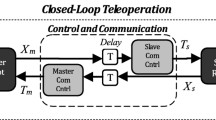Abstract
A new impedance controller is proposed for bilateral teleoperation under a time delay. The proposed controller does not need to measure or estimate the time delay in the communication channel using the force loop-back. In designing a stable impedance controller, absolute stability is used as a stability analysis tool, which results in a less conservative controller than the passivity concept. Moreover, in order to remove the conservatism associated with the assumption of infinite port impedances, the boundaries of human and environment impedance are set to finite values. Based on this, this paper proposes a parameter design procedure for stable impedance controllers. The validity of the proposed control scheme is demonstrated by experiments with a 1-dof master/slave system.
Similar content being viewed by others
Abbreviations
- T1 :
-
Time delay from the master to the slave
- T2 :
-
Time delay from the slave to the master
- Ze,max :
-
Maximum of the environment impedance
- Zh,max :
-
Maximum of the human impedance
- Zh,min :
-
Minimum of the human impedance
- m, b, k:
-
Mass, damping, and stiffness in the desired impedance
- f*(w):
-
Modified absolute stability criterion
- fe :
-
Force exerted on the slave by its environment
- fh :
-
Force applied at the master by the operator
- kf :
-
Force scale factor
- kp :
-
Position scale factor
- m, b:
-
Mass and viscous coefficient in dynamics
- u:
-
Input torque of the device
- x:
-
Position of the device
References
Adams, R. J. and Hannaford, B., 1999, “Stable Haptic Interaction with Virtual Environments,”IEEE Transactions on Robotics and Automation, Vol. 15, No. 3, pp. 465–474.
Adams, R. J. and Hannaford, B., 2002, “Control Law Design for Haptic Interfaces to Virtual Reality,”IEEE Transactions on Control Systems Technology, Vol. 10, No. 1, pp. 3–13.
Anderson, R. J. and Spong, M. W., 1989, “Bilateral Control of Teleoperators with Time Delay,”IEEE Transactions on Automatic Control, Vol. 34, No. 5, pp. 494–501.
Cho, H. C., Park, J. H., Kim, K. and Park, J. O., 2001, “Sliding-Model-Based Impedance Controller for Bilateral Teleoperation under Varying Time-Delay,”IEEE International Conference on Robotics and Automation, pp. 1025–1030.
Colgate, J. E., 1993, “Robust Impedance Shaping Telemanipulation,”IEEE Transactions on Robotics and Automation, Vol. 9, No. 4, pp. 374–384.
Dubey, R. V., Chan, T. F. and Everett, S. E., 1997, “Variable Damping Impedance Control of a Bilateral Telerobotic System,”IEEE Control Systems Magazine, Vol. 17, No. 1, pp. 37–44.
Hannaford, B., 1989, “Stability and Performance Tradeoffs in Bilateral Telemanipulation,”IEEE International Conference on Robotics and Automation, pp. 1764–1767.
Hashtrudi-Zaad, K. and Salcudean, S. E., 2001, “Analysis of Control Architecture for Teleoperation Systems with Impedance/Admittance Master and Slave Manipulators,”International Journal of Robotics Research, Vol. 20, No. 6, pp. 419–445.
Haykin, S. S., 1970,Active Network Theory, Addison-Wesley.
Hogan, N., 1985, “Impedance Control: An Approach to Manipulation : Part I-Theory,”Journal of Dynamic Systems, Measurement, and Control, Vol. 107, No. 1, pp. 1–7.
Hwang, D. Y., Hannaford, B. and Choi, H. R., 2001, “Identification of Feasible Scaled Teleoperation Region Based on Scaling Factors and Samping Rates,”KSME International Journal, Vol. 15, No. 1, pp. 1–9.
Kim, J.H., Chang, P. H. and Park, H. S., 2003, “Transparency Implementation for Bilateral Teleoperation System by Using Two-Channel Control Architecture,”KSME (in Korea), Vol. 27, No. 11, pp. 1967–1978.
Lawrence, D. A., 1993, “Stability and Transparency in Bilateral Teleoperation,”IEEE Transactions on Robotics and Automation, Vol. 9, No. 5, pp. 624–637.
Llewellyn, F. B., 1952, “Some Fundamental Properties of Transmission Systems,”Proceedings IRE, pp. 271–283.
Niemeyer, G. and Slotine, J. E., 1997, “Using Wave Variables for System Analysis and Robot Control,”IEEE International Conference on Robotics and Automation, pp. 1619–1625.
Park, J. H., Song, J. H. and Cho, H. C., 2000, “Impedance Modulation for a Teleoperator Using Distance Measurement,”International Conference on Control, Automation, Robotics and Vision, Paper #157.
Raju, G. J., Verghese, G. C. and Sheridan, T. B., 1989, “Design Issues in 2-Port Network Models of Bilateral Remote Manipulation,”IEEE International Conference on Robotics and Automation, pp. 1316–1321.
Rubio, A., Avello, A. and Florez, J., 1999, “Adaptive Impedance Modification of a Master-Slave Manipulator,”IEEE International Conference on Robotics and Automation, pp. 1794–1796.
Author information
Authors and Affiliations
Corresponding author
Rights and permissions
About this article
Cite this article
Cho, H.C., Park, J.H. Design and stability analysis of impedance controller for bilateral teleoperation under a time delay. KSME International Journal 18, 1131–1139 (2004). https://doi.org/10.1007/BF02983287
Received:
Revised:
Published:
Issue Date:
DOI: https://doi.org/10.1007/BF02983287




